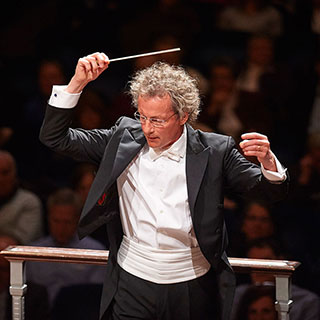Cleveland Orchestra closes season with lightweight Italian program
The Cleveland Orchestra was in prime form for the final season program of the ensemble’s Miami residency Friday night at the Arsht Center. With music director Franz Welser-Möst on the podium, the Italian-themed program featured one of the masterpieces of the symphonic repertoire, a glittering orchestral showpiece and some balletic potboilers.
Mendelssohn’s Symphony No. 4 in A Major (“Italian”) opened the evening. Welser-Möst offered sunny Mendelssohn with a strong rhythmic impetus running throughout the symphony’s four movements. In the opening Allegro vivace, the ensemble’s plush string sonority and Joshua Smith’s pure-toned flute provided rich orchestral colors. Winds and strings were well balanced and Welser-Möst finely detailed instrumental lines without loss of momentum. The pilgrim’s march of the Andante was taken at a stately pace and the horn trio of the third movement assayed with strength and accuracy. Welser-Möst attacked the finale at a hard-driving pace. He nicely differentiated between the saltarello and tarantella melodies through slight variance of tempo and phrasing.
If the Mendelssohn demonstrated the Clevelanders’ bona fides in a major orchestral work, two ballet suites created by Giuseppe Verdi for the Paris productions of his operas displayed how a world-class ensemble can make minor scores sound better than they are.
The 1865 ballet music from Macbeth verges on vulgarity. With taut control and careful attention to dynamic contrasts, Welser-Möst managed to bring some subtlety to this rather blatant trifle. The dance sequence from the original French version of Don Carlos is considerably more inventive. (George Balanchine utilized the score for his ballet Ballo della Regina.) There were shimmering textures in the strings and concertmaster William Preucil’s dark hues and patrician shaping of melodic phrases took solo honors. The final Prestissimo was particularly lithe and spirited. While these infrequently played scores fitted the concert’s thematic context, one could not help wonder whether first-rate performances should be wasted on such lightweight trifles– particularly with the Cleveland residency shrinking to just two programs next season.
Ottorino Respighi’s Pines of Rome is a popular symphonic blockbuster and the Clevelanders’ performance aptly demonstrated why this tone poem is so frequently performed. When played by a world-class ensemble, Respighi’s synthesis of impressionism, tinted orchestral colors and Italianate vibrancy makes a terrific impact.
Welser-Möst held back in the opening “Pines of the Villa Borghese,” bringing out individual instrumental roles rather than turning the opening bars into an over-the-top eruption. Dark tones in the lower strings and brass effectively evoked the “Pines Near a Catacomb.” The build up to the big crescendo was effectively controlled with the climactic full ensemble flourish at peak velocity. Harp and string underlining came through clearly over the recorded birdsong in “The Pines of the Janiculum.” With an extra brass choir stationed in the first balcony toward the rear of the hall, Welser-Möst unleashed the orchestra’s full force in Respighi’s depiction of the Roman army marching up “The Pines of the Appian Way.”
The Cleveland Orchestra repeats the program 8 p.m. Saturday at the Arsht Center in Miami. arshtcenter.org
Posted in Performances
Leave a Comment
Sat Mar 25, 2017
at 12:39 pm
No Comments







